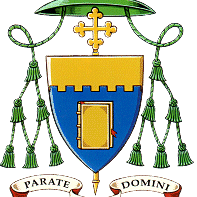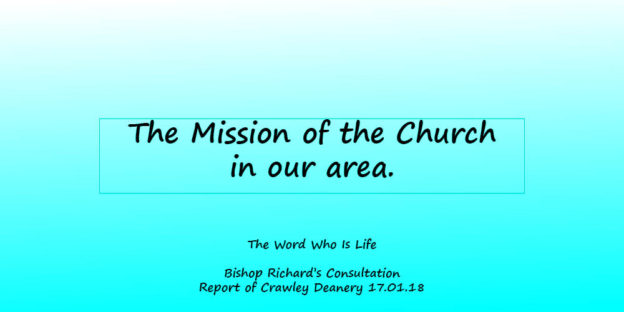THE WORD WHO IS LIFE
Bishop Richard’s Consultation
Report of Crawley Deanery 17.01.2018
Part I (read part two here)
Summary of responses received to the five questions
The consolidated responses below are compiled from those received from parish groups; some of the groups had opportunity to consult their local parish communities, whilst others responded as representatives of their communities:
- Given the Mission which has been entrusted to us, what three things do you think we most need for Mission-effectiveness?
- A genuine desire for change focused on a clear vision for increased conversion and discipleship.
- This must be expressed regularly to raise the awareness of the whole community and to generate an optimistic excitement for the mission itself.
- Evangelii Gaudium (para 15): We “cannot passively and calmly wait in our church buildings”; we need to move “from a pastoral ministry of mere conservation to a decidedly missionary pastoral ministry”
- EG 25: A “pastoral and missionary conversion” is called for “which cannot leave things as they presently are.”
- The status quo is not an option and we pray that this consultation is an essential first commitment to the need to progress the mission as a matter of urgency.
- 2030 is 13 years away but, more importantly, it is only 5/6 years away from the entry date for any future priest who completes training by 2030. This 5/6 year window is the first target. A revitalised and outgoing Church will create a deeper and larger pool from which applicants can be drawn; even if the current demands of celibacy and seven years preparation remain.
- To focus only on the number and distribution of priests will condemn the mission to failure before it begins – reduced priest numbers are only a spin-off from the much more important and pressing goal of bringing, or returning, the wider world to Jesus — our mission mandate
- Faith-filled, fully collaborative, welcoming and outward-looking Eucharistic communities, calling for attention to:
- evangelising the baptised (forming intentional disciples) – the provision of effective adult catechesis and formation for mission – increasing understanding of, and participation, in Mass & Sacraments
- Given its centrality to the whole mission, the ‘attractiveness’ of the Mass for all parishioners must be addressed – clearly retaining the Eucharist as the pinnacle of our lives, while developing the environment within which it is offered, eg, music, welcome, children’s liturgy, a range of Mass settings, etc.
- Development of truly collaborative ministry with fully involved laity, requiring increased understanding and willingness to participate of both clergy and lay faithful
- Ensuring that parish communities are invitational and truly inclusive – actively welcoming and providing for all marginalised groups, newcomers and ‘enquirers’ – being a known active part of the local district community
- Ensuring that parish communities are outward-looking: socially-aware and attentive to those in any kind of need – equipped and willing to proclaim the Gospel, directly as well as by good example – being ecumenically aware and active – applying Catholic Social Teaching in daily life
- Effective leadership, teaching, formation and support from the clergy in pursuance of the mission activity of the lay faithful.
- What roles in this Mission belong to the Priest?
In terms of the baptismal mission of all the faithful, few things “belong” to the priest that do not belong to the lay faithful also. Insofar as the practical distinction be made that it is the role of the lay faithful to take the Word of God to the world, the role of the priest is then to build up the lay faithful to prepare, equip and support them for their role. The three key duties of the priest so define his role:
- Teaching – ‘Making present, in the bewilderment and confusion of our times, the light of God’s Word’ ( Pope Benedict XV1). The homily offers the key teaching for most parishioners and should be of high quality and relevance, but attendance at other opportunities for evangelisation, catechesis and formation must be encouraged
- Sanctifying – Ensuring that the sacramental life of the Church is strong and invitational.
- Governing (leading) – Within the mission, the leadership of the priest should reflect the servant leader model made visible in the life and teaching of Jesus. ‘Feed (not rule) my sheep’. The priest must be the animator of, and collaborative worker with, his people.
- What roles in this Mission can be best carried out by the lay-faithful?
The responses received from the parish core groups make it evident that whilst there is good awareness of the potential role of the lay faithful in sustaining and supporting the parish itself, there is currently very little awareness or understanding amongst the lay faithful of their being called to any proactive sense of ‘mission’. All but a very few comments in response to Q3 have related to activity within the parish (though prayer for vocations gets mentioned). In this situation, attention needs to be given to:
- Moving from ‘ministry within the parish’ to ‘intentional discipleship’: Given the core purpose of the Church, the key role for the lay faithful must be to take the Gospel to the world. If they are valued, trusted and supported they can ‘take on’ anything other than ‘ordained’ roles, but they cannot pass on what they do not themselves have. A great deal of adult formation and sacramental preparation has already been successfully organised and implemented by the lay faithful and this should be built upon if the mission mandate is to be realised.
- Ministry: The lay faithful already demonstrate an ability and willingness to support important roles/tasks across the parish (including tasks of an admin nature). Organisations and committed individuals offer ministries in a range of ways and energy and support must be given to broaden and deepen this work even further (e.g. in marriage preparation, in which there can often be a strong evangelisation/missionary dimension)
- Witnessing to faith in everyday life: The primary role of lay people is to live daily lives with God at the centre of all that they do. In their everyday lives, they encounter people in all sorts of needs and distress and thus have many opportunities to witness to their faith in the way in which they respond, at work, within their families and within the wider social context.
- What factors, do you think, have brought about the present situation that we are having to address in our Diocese?
From the responses it is clear that there was some confusion as to whether the question is about ‘shortage’ of priests or about a general decline of Mass attendance and parish life. However, the two overlap since many of the factors mentioned relate, at least indirectly, to both:
- Cultural: individualism/celebrity cult – unwillingness to commit – children no longer simply follow their parents’ Mass attendance – generally cynical/hostile media and society – materialist/secularist society – events-dominated family life displacing regular Mass attendance – ‘pray, pay and obey’ not enough.
- Quality of faith/church life: Lack of regular Mass attendance (by all but the elderly) – insufficient encouragement to young men to consider vocation – weakening of ‘domestic church’ – shallow spirituality – lack of attention to evangelization – women’s gifts and potential underutilised – frustration from too little responsibility being given to/taken by lay faithful – lack of adult catechesis/regular formation for the evangelised (many still have ‘primary school’ knowledge and expectations of faith) – failure to engage with youth – few Catholic school leavers are ‘intentional disciples’ who practise their faith.
- A battered perception of the Church: scandals and the Church’s response to them – priesthood qualification (celibate, male) too restricted, and priestly life not seen as attractive – an apparent desire to dilute the opportunities presented by Vatican II – a reversion to ‘rubric, ritual and vestment’ – apparent desire to retain a hierarchical approach to leadership
- Lack of meaningful mission/ outreach to the whole range of non evangelised – from many existing church goers to the lapsed and the un -churched.
- Too much ‘shifting of deck chairs’ rather than effective management and implementation of necessary change
- A lack of formation in vision and leadership for many of those given the pastoral care of parishes.
- If we were starting the Diocese today, with 25 priests, where would you place them? (Note: the diocese currently has 89 parishes, comprising 128 churches and 12 chapels.)
- In centres of population – where the Church can best be centred to effect the greatest fruitfulness in mission – especially in socially deprived areas – where there are largest Mass attendances – places accessible by public transport – where there are Catholic schools
- Group priests in regional ‘hub’ presbyteries – key/well-placed outlying parishes to be developed as community-led outreach centres – we would not be starting from scratch: there is an existing network of communities which need to be respected and promoted.
Read part two of the report here


Comments are closed